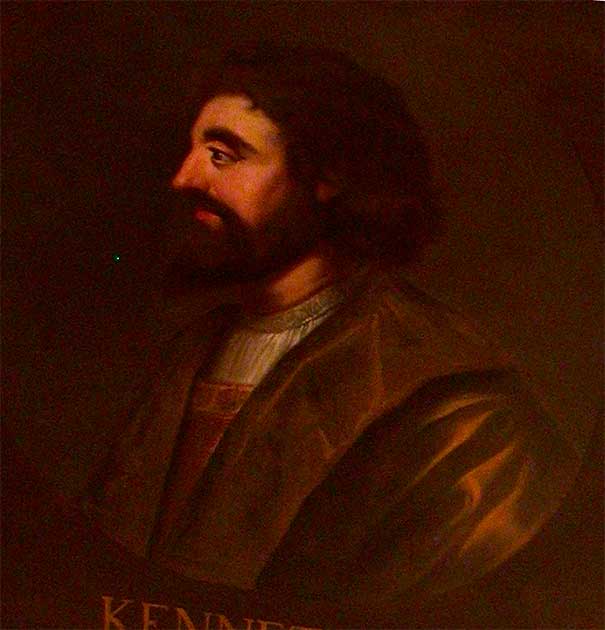Killing a king is necessarily a hard thing to do, and most are extremely well guarded. If you aim for the top, you should come well prepared, but perhaps not quite as well prepared as Finella was in this story.
It concerns a Scottish king named Cináed mac Maíl Coluim, typically anglicized to King Kenneth II, who was the King of Alba from 971 to 995. His lifespan was from 932 to 995.
He was the son of Malcolm I and had a brother named Duff, who became the King of Alba in 966. King Kenneth took control of the throne by defeating the Britons, possibly, or maybe it was through treachery, after his predecessor was slain. Records blur into myth at this point in Scottish history.
Kenneth II’s reign was blotted with conflict, and he first defeated the Britons of Strathclyde. Then, he went on to fight with the King of Northumbria. In both conquests, King Kenneth II was successful and expanded Alba to these parts of Scotland. His territory spread from the River Forth to the River Tweed.
A War Leader
Having won territory and established a larger kingdom than his predecessors, Kenneth’s main rival was the English King Edgar and his forces. In the North, King Kenneth II also faced challenges. The northern territory was threatened by the forces of Sigurd, Earl of Orkney.
However, Kenneth II strengthened his hold on his territories by building strong ties with the Irish nobility and eventually married the princess of Leinster. Many historians claim that in 973, King Kenneth II submitted and recognized the reign of King Edgar of England.

In return for this recognition, he was granted the lands of Lothian. This might be the first time the River Tweed was used as the border between England and Scotland, and while that certainly shifted much over the following centuries, it is still the current border today.
In 994, however, the King broke the treaty between England and Scotland when he decided to invade England. He would lose this war and lost the land of Lothian to the English, but it is the manner of his death which interests the most.
This blood feud continued until the death of King Kenneth II at Fettercairn at the hands of his own nobles and his predecessor’s son Constantine. The assassination of King Kenneth II was weird and a classic example of deceit.
The deceitful plan was made by Finnguala, or Lady Finella, the daughter of Cuncar, Mormaer of Angus. The lady held a deep vengeance for King Kenneth II as he had killed her only son. Therefore, she went on to plan his assassination and successfully executed it too.
Finella lived in the southwestern area of Fettercairn, a small village in Aberdeenshire. The castle of Greencairn, where Finnella lived, was the seat of power for Momaer of Angus.
Equipment by Rube Goldberg
The plot of this assassination begins from the time when King Kenneth II wanted to exert a greater control over his subjects and establish order in different parts of Alba. He wanted to tame the rebels, refine the behavior of his countrymen and bring peace after years of war.
Finella’s son, Cruthlint, was one such rebel who conflicted with the King. He would often raid the land and steal things from the common population of Alba. After this unruly behavior from one of his nobility, the King sent out a proclamation: Cruthlint was ordered to appear at Scone in a fortnight and answer for his deeds that brought misery upon the public of Alba.
After being summoned by the King, Cruthlint knew the clock was ticking. So he promptly fled to the Highlands and hid there. Kenneth II was determined to catch the miscreant and pursued him, finally capturing Cruthlint at Lochaber.
He was then brought to the Castle of Dunsinane, and there he was executed. This incident started the blood feud, and vengeance between Lady Finella and King Kenneth II. Lady Finella had started planning for the death of the King ever since her son was executed.
Apart from Lady Finella, there were other enemies of the King, traitors in his own ranks. The conspirators of his assassination were Constantine and another Kenneth, both of whom would succeed the unlucky King, who joined Lady Finella in her plan.
The two noblemen were keen on killing Kenneth II because he was trying to change the rules of succession. He was changing the rules of succession so that after him, only his bloodline could sit on the throne of Alba. This irked the two noblemen as they realized they could never be King of Alba after the amendment.
The Death of King Kenneth II
Finella was cunning and a keen huntress. King Kenneth II was aware of the wrath Lady Finella possessed for him. Therefore, Finella pretended to forgive King Kenneth II for the death of her son.
As a gesture of goodwill, Finella invited the King to hunt at the grounds of her castle and lodge there. During the hunt in which she accompanied the King, she exclaimed about some conspiracy to kill the King, which she would reveal to him to protect him from assassination.

She also tried to gain the trust of the King by showing her support for his decision to kill her son. She spoke in favor of the execution of Cruthlint and proclaimed that King Kenneth II was a just king.
But she had gone even further than this: Finella had arranged a feast in honor of the King and his men. After the feast, she invited the King into her chamber and presented a golden statue that resembled a king. As King Kenneth II was admiring the statue, he asked about a ring that was on the hand of the statue. The ring was beautiful, with many precious stones on it.
Lady Finella then told him that the ring was a gift from her and urged him to take it off the statue. King Kenneth II, who was not expecting any treachery, did as Lady Finella asked.
The ring was actually a trigger for a hidden mechanical crossbow inside the statue, which shot arrows the moment the ring was removed. When the King removed the ring, he was shot with arrows and wounded fatally.
As Kenneth, riddled with arrows, lay dying, his loyal men tried to capture Lady Finella. Lady Finella had fled to the coast by then and leapt over a waterfall to her death. Some historical accounts say that Lady Finella was later captured and burnt at her castle.
Top Image: King Kenneth II was killed by a flurry of arrows, launched when he touched a booby-trapped statue. Source: Oleksandr / Adobe Stock.
By Bipin Dimri